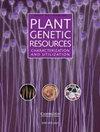In situ characterization of tamarind (Tamarindus indica L.) fruit and spotting sweet tamarind types in Palakkad gap of Kerala
IF 0.7
4区 生物学
Q3 PLANT SCIENCES
Plant Genetic Resources: Characterization and Utilization
Pub Date : 2023-08-23
DOI:10.1017/s1479262123000588
引用次数: 0
Abstract
Kerala, a humid tropical southern state, is the third largest producer of Tamarind (Tamarindus indica L.) in India. This tree spice is an important livelihood option for the rural society, especially in Palakkad district which is the lead producer of tamarind in the state with a few accepted primitive cultivars, viz. ‘valanpuli’, ‘madhurapuli’ and ‘thenpuli’. A survey was conducted to identify the fruit variability and document the sweet tamarind types of Palakkad. This study revealed the variability and weight of 30 fruits was seen to be the most indicative variable of tamarind in Kerala. The pod length varied from 5.28 to 23.41 cm and fruit weight from 4.83 to 43.40 g. Hierarchical clustering on principal component analysis resulted in six clusters. The clusters I, IV and V represented collections with fruit weight more than 20 g. Box plot diagrams revealed the high real pulp value in sample KTJ 162 (9.57) and high fruit length in KTJ 44 (21.68 cm). Among 113 collections, 18 samples were collected as perceived sweet types based on local enquiry. In the scatter plot between total soluble solids and ratio between total soluble solids and total titrable acidity, two samples were spotted as sweet types with acidity below 8%. Further molecular characterization and systematic crop improvement programmes are required for conserving the eroding gene pool of tamarind in Kerala and to develop sweet types for commercial production.喀拉拉邦Palakkad林隙罗望子(Tamarindus indica L.)果实和点状甜罗望子类型的原位鉴定
喀拉拉邦是一个潮湿的热带南部邦,是印度第三大罗望子(Tamarindus indica L.)产地。这种树香料是农村社会的重要生计选择,特别是在Palakkad地区,这里是该州罗望子的主要生产地,有几个公认的原始品种,即“valanpuli”,“madhurapuli”和“thenpuli”。进行了一项调查,以确定果实的变异性,并记录了帕拉卡德甜罗望子的类型。该研究表明,30个水果的变异性和重量被认为是喀拉拉邦罗望子最具指示性的变量。荚果长5.28 ~ 23.41 cm,果实重4.83 ~ 43.40 g。主成分分析的层次聚类结果为6个聚类。集群I, IV和V代表果实重量大于20 g的集合。箱形图显示,样品ktj162的实果肉值较高(9.57 cm),样品ktj44的果长较高(21.68 cm)。在113个样品中,18个样品是根据当地查询收集到的感知甜味类型。在总可溶性固形物与总可溶性固形物与总可滴定酸度之比的散点图中,有两个样品被标记为酸度低于8%的甜型。需要进一步的分子鉴定和系统的作物改良计划来保护喀拉拉邦受侵蚀的罗望子基因库,并开发用于商业生产的甜型罗望子。
本文章由计算机程序翻译,如有差异,请以英文原文为准。
求助全文
约1分钟内获得全文
求助全文
来源期刊

Plant Genetic Resources: Characterization and Utilization
Agricultural and Biological Sciences-Agronomy and Crop Science
CiteScore
2.80
自引率
0.00%
发文量
29
审稿时长
>12 weeks
期刊介绍:
Plant Genetic Resources is an international journal which provides a forum for describing the application of novel genomic technologies, as well as their integration with established techniques, towards the understanding of the genetic variation captured in both in situ and ex situ collections of crop and non-crop plants; and for the airing of wider issues relevant to plant germplasm conservation and utilisation. We particularly welcome multi-disciplinary approaches that incorporate both a technical and a socio-economic focus. Technical aspects can cover developments in technologies of potential or demonstrated relevance to the analysis of variation and diversity at the phenotypic and genotypic levels.
 求助内容:
求助内容: 应助结果提醒方式:
应助结果提醒方式:


